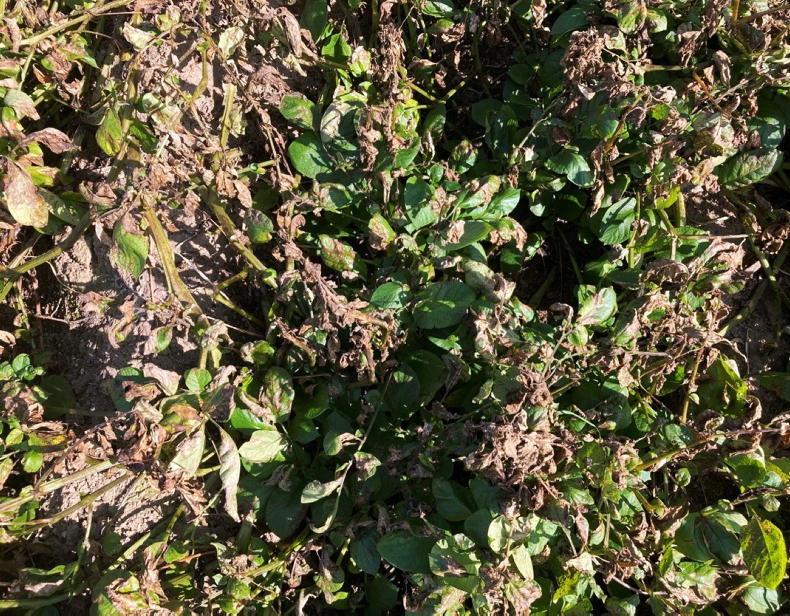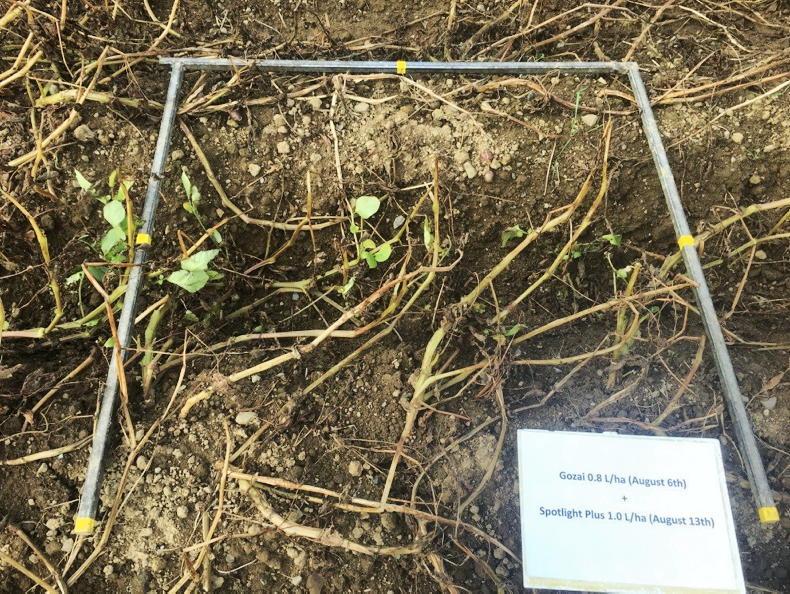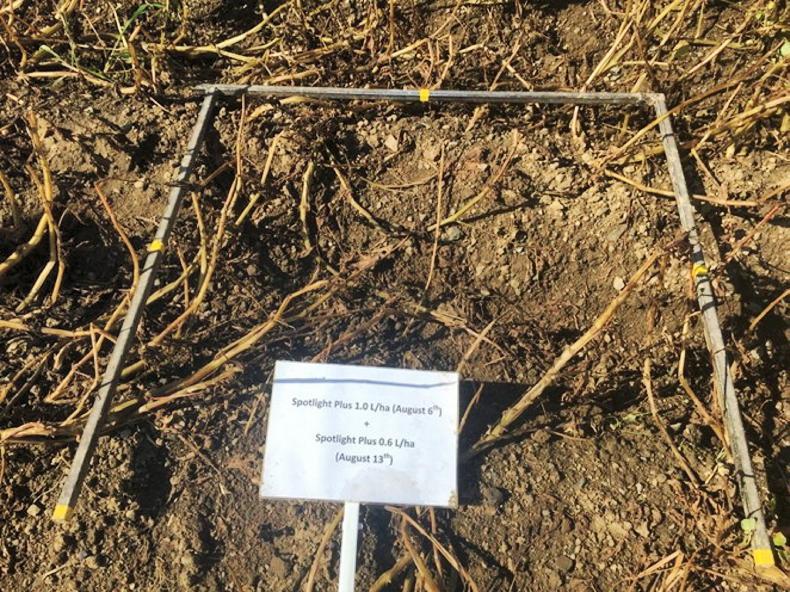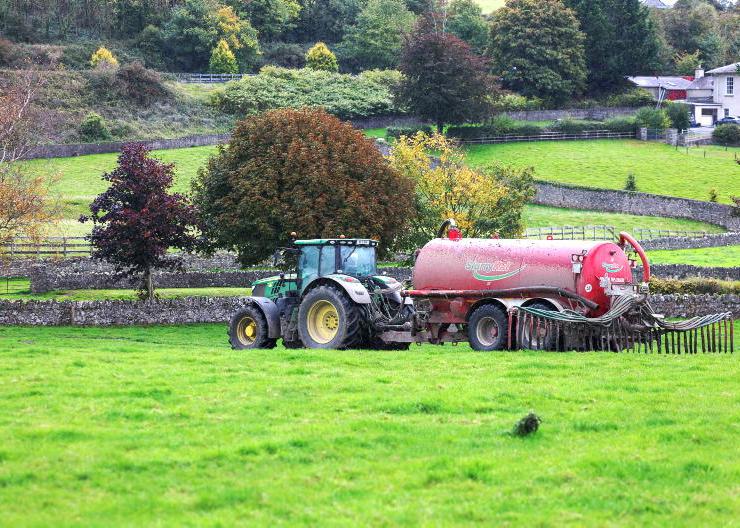The 2019 season was the last where widespread use of the potato haulm desiccant herbicide diquat was allowed. It’s rare that the loss of a tool can result in such a fundamental change in how crops need to be produced.
This is the case with diquat, and while it was granted a temporary derogation in September, it is unlikely we will see this again in 2021.
This season, many growers experimented with other techniques to help destroy potato haulms. The most common products trialled were Spotlight Plus (carfentrazone-ethy) and Gozai (pyraflufen-ethy), along with mechanical flailing.
Many growers also trialled alternative techniques to destroy haulms, including the addition of adjuvants and the use of trace elements and salts.

Two weeks post T1 of Gozai (0.8l/ha) Tullow
Irish trials
Facing into our first season without diquat, what was clear was the lack of Irish-specific trial work on these new haulm destruction methods. Potato varieties grown here generally have larger haulms compared to varieties grown in Europe, making the challenge of effective haulm destruction even greater. It also means that much of the information from Europe – and even England – around alternative destruction methods aren’t directly applicable here.
In an effort to address this, Teagasc conducted two in-field demonstrations this year. I caught up with Shay Phelan, crops specialist with Teagasc, to discuss the results of the demonstration.

Spotlight Plus (1l/ha) followed by Gozai (0.8l/ha) Lyons
Two scenarios
Shay explained that he wanted to create two demonstration scenarios. The first one was in Lyons Estate, Co Kildare, where field, crop, conditions and time of year were perfect for these alternative methods of haulm destruction.
The second was in Tullow, Carlow, which was the opposite. At this site, the crop was planted later, received a higher nitrogen rate and had treatments applied later in the season. Table 1 outlines the details of the two sites. The demonstration trialled nine different combinations, including flailing, Spotlight Plus, Gozai and Fazor Star (maleic hydrazide), Boron, Copper and the use of adjuvants.
The observations for the Tullow site are still ongoing, but comparisons can be drawn between it and the Lyons site in the pictures above.

Gozai (0.8l/ha) followed by Spotlight Plus (1l/ha) - Lyons
Results
As expected, treatments on the Lyons crop were more effective in all cases.
A two spray programme (with no flailing), using either/both Spotlight Plus or Gozai, effectively burned down the crop canopy, allowing the harvest to commence within four to five weeks after the T1. Conditions at the time of product application were good, with high UV light interception.
Crucially, the crop was close to early senescence before the T1 application, due in part to the lower nitrogen rate and early planting date. When using a flail, the results were as effective as using diquat, with crops ready for harvest in two weeks.
The results from the Tullow demonstration prove the real challenge facing growers. There was a marked difference in the effectiveness of all programmes after two weeks compared to the Lyons crops. Last week, Shay visited the Tullow crops again, four weeks after their first herbicide treatment. The crops were still not fit for harvest and would likely require an application of diquat to finish them off.
In all cases, the addition of trace elements didn’t prove to be beneficial.
Take home message
The demonstrations show the need to plan the entire management of the crop, from start to finish. Spotlight Plus and Gozai can work. However, they are designed to work on crops of a certain condition. If those conditions are not met at the time of application, you won’t see the desired results.
Shay explains that in order to have the main crop fit for harvest on 1 October, your T1 herbicide must be applied four weeks earlier. The crop needs to be in the early stages of senescence when the T1 is being applied.
That means tailoring nitrogen rates according to the crop’s needs and ground type, but also managing planting dates. Where planting is possible in March, this is relatively simple.
However, in cases where planting isn’t possible until mid-April onwards, then seed may have to be warmed to open the eyes, or possibly even chitted before planting in order to hit that senescence target of early September. Otherwise, the only option for those haulms is mechanical flailing.
Flailing, followed by an application of Spotlight or Gozai, is highly effective. However, this method requires good ground conditions, very good disease control towards the end of the season, correct machine set-up and hygiene, as well as a pest control strategy.
The 2019 season was the last where widespread use of the potato haulm desiccant herbicide diquat was allowed. It’s rare that the loss of a tool can result in such a fundamental change in how crops need to be produced.
This is the case with diquat, and while it was granted a temporary derogation in September, it is unlikely we will see this again in 2021.
This season, many growers experimented with other techniques to help destroy potato haulms. The most common products trialled were Spotlight Plus (carfentrazone-ethy) and Gozai (pyraflufen-ethy), along with mechanical flailing.
Many growers also trialled alternative techniques to destroy haulms, including the addition of adjuvants and the use of trace elements and salts.

Two weeks post T1 of Gozai (0.8l/ha) Tullow
Irish trials
Facing into our first season without diquat, what was clear was the lack of Irish-specific trial work on these new haulm destruction methods. Potato varieties grown here generally have larger haulms compared to varieties grown in Europe, making the challenge of effective haulm destruction even greater. It also means that much of the information from Europe – and even England – around alternative destruction methods aren’t directly applicable here.
In an effort to address this, Teagasc conducted two in-field demonstrations this year. I caught up with Shay Phelan, crops specialist with Teagasc, to discuss the results of the demonstration.

Spotlight Plus (1l/ha) followed by Gozai (0.8l/ha) Lyons
Two scenarios
Shay explained that he wanted to create two demonstration scenarios. The first one was in Lyons Estate, Co Kildare, where field, crop, conditions and time of year were perfect for these alternative methods of haulm destruction.
The second was in Tullow, Carlow, which was the opposite. At this site, the crop was planted later, received a higher nitrogen rate and had treatments applied later in the season. Table 1 outlines the details of the two sites. The demonstration trialled nine different combinations, including flailing, Spotlight Plus, Gozai and Fazor Star (maleic hydrazide), Boron, Copper and the use of adjuvants.
The observations for the Tullow site are still ongoing, but comparisons can be drawn between it and the Lyons site in the pictures above.

Gozai (0.8l/ha) followed by Spotlight Plus (1l/ha) - Lyons
Results
As expected, treatments on the Lyons crop were more effective in all cases.
A two spray programme (with no flailing), using either/both Spotlight Plus or Gozai, effectively burned down the crop canopy, allowing the harvest to commence within four to five weeks after the T1. Conditions at the time of product application were good, with high UV light interception.
Crucially, the crop was close to early senescence before the T1 application, due in part to the lower nitrogen rate and early planting date. When using a flail, the results were as effective as using diquat, with crops ready for harvest in two weeks.
The results from the Tullow demonstration prove the real challenge facing growers. There was a marked difference in the effectiveness of all programmes after two weeks compared to the Lyons crops. Last week, Shay visited the Tullow crops again, four weeks after their first herbicide treatment. The crops were still not fit for harvest and would likely require an application of diquat to finish them off.
In all cases, the addition of trace elements didn’t prove to be beneficial.
Take home message
The demonstrations show the need to plan the entire management of the crop, from start to finish. Spotlight Plus and Gozai can work. However, they are designed to work on crops of a certain condition. If those conditions are not met at the time of application, you won’t see the desired results.
Shay explains that in order to have the main crop fit for harvest on 1 October, your T1 herbicide must be applied four weeks earlier. The crop needs to be in the early stages of senescence when the T1 is being applied.
That means tailoring nitrogen rates according to the crop’s needs and ground type, but also managing planting dates. Where planting is possible in March, this is relatively simple.
However, in cases where planting isn’t possible until mid-April onwards, then seed may have to be warmed to open the eyes, or possibly even chitted before planting in order to hit that senescence target of early September. Otherwise, the only option for those haulms is mechanical flailing.
Flailing, followed by an application of Spotlight or Gozai, is highly effective. However, this method requires good ground conditions, very good disease control towards the end of the season, correct machine set-up and hygiene, as well as a pest control strategy.













SHARING OPTIONS